
views
Getting an Education

Obtain your high school diploma or GED. Before getting formal training and certification in auto body repair, you’ll need to obtain your high school diploma or GED. This is often the only requirement to enter a vocational school program, though some programs might require your ACT or SAT scores as well. If possible, join a technical program at your school to get training as an auto tech while in high school. If there is an auto body repair program at a nearby high school (or even a nearby community college), talk to your school’s principal or counselor about attending the program there for school credit. If you’re trying to get your GED, look for free preparation courses at your local library or community education center. If you’re studying for any test -- GED, SAT, or ACT -- check out the study guides from your local library. Use them to prepare for your test.

Get certified. Specialized education from a trade school is usually a requirement for becoming an auto body repair technician. At the very least, it will make you a preferred candidate when applying for jobs, enable you to become better at your job, and qualify you for a higher wage. Trade and technical schools often have programs offering certification for auto body repair or collision repair. Locate a school near you that offers auto body repair certification and enroll in the appropriate courses to earn your certification. Check https://www.trade-schools.net/trades/auto-body.asp to search a database of trade schools that offer auto body technician certification.

Get on-the-job training. Usually, you’ll enter the job with some level of familiarity with auto maintenance and repair. You will then be trained in all the skills and abilities that you’ll need to become an auto body repair technician, including: Repairing hybrid vehicles Welding damaged vehicles Aligning auto chassis Estimating the cost of repairs Replacing structural components
Growing in the Profession
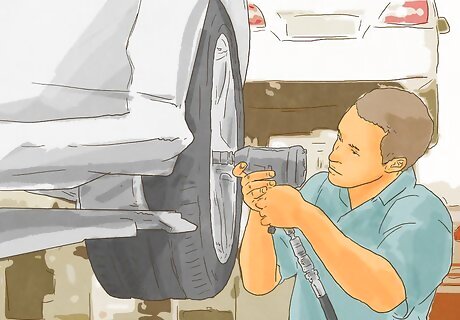
Become an apprentice. Either before or during your formal training, you should apply to become an apprentice. This will give you valuable hands-on experience as you assist the senior auto body repair techs in the shop. Your apprenticeship will look great on a resume when you apply for jobs later. The specific process for becoming an apprentice depends on the business you apprentice for. Start by contacting local auto body repair shops to find out if they hire part-time employees or apprentices. Explain your interest in becoming an auto body repair tech and offer your services as an apprentice. You might be able to get college credit for time spent as an apprentice. Talk to your training program advisor for more information.

Get a job. As an auto body repair technician, you will probably gain employment at an auto body repair shop or an auto dealership. You might also look for work at a custom automotive shop. Additionally, you can work at companies that maintain large fleets of automobiles. Check online at Indeed and LinkedIn for work opportunities in your area. Check your local newspaper for advertisements for auto body repair technicians. Ask your instructors during your vocational school training for advice about getting a job. They often have connections in the industry they can call on to help you.
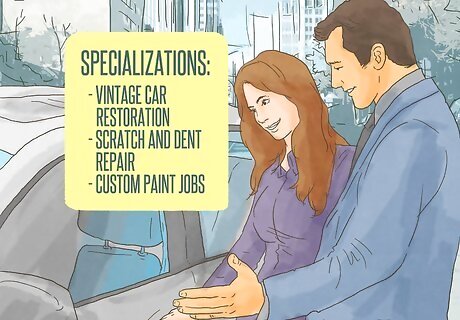
Choose a specialization. As an auto body repair tech, you will be able to do several things well, but there should be at least one thing that you do with a high degree of precision. Identify your favorite aspect of the job and develop the skills necessary to make you the go-to person for that specialization. For instance, you might specialize in: restoring vintage cars removing dents touching up paint scratches designing unique paint jobs

Continue learning. As new technologies and automotive repair techniques become available, the old technologies and parts will fall out of use. Stay up-to-date on the latest advances in auto repair by reading technical manuals, taking continuing education classes at vocational schools, and conferring with your colleagues when you have a challenge you need help with. Parts, materials, electronics, and air bags are constantly changing and becoming more complex. Stay informed to ensure you’re providing safe, high-quality auto body repair work. Ongoing training is also offered through the Inter-Industry Conference on Auto Collision Repair (I-CAR).
Getting Certified

Register with the National Institute for Automotive Service Excellence (ASE). The ASE is a nonprofit organization that offers standardized certification programs in a variety of auto repair specialties. While ASE certification might not be necessary to work in every employment center, it will give you a solid background in auto body repair and look great on your resume. Create a login at www.ase.com/Tests/ASE-Certification-Tests/Register-Now.aspx. In the gold box, click “Create myASE Account.” Fill in the necessary information and activate your account.
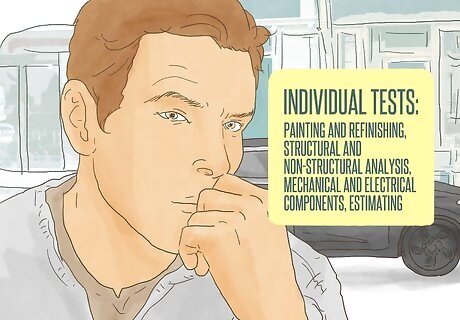
Decide which tests you want to take. Think about the areas you wish to learn more about or specialize in. There are several tests you could take to bolster your skill as an auto body repair technician, and you don’t need to choose just one. As an auto body repair tech, the most useful certifications you could earn would be series B2 through B5. Obtaining these certifications will qualify you as a Master Collision Repair Technician. An additional test, B6, is optional. The individual tests include: Test B2 (Painting & Refinishing), which consists of 55 scored questions. Test B3 (Non-Structural Analysis & Damage Repair) also consists of 55 scored questions Test B4 (Structural Analysis & Damage Repair), which consists of 50 scored questions Test B5 (Mechanical & Electrical Components) also consists of 50 scored questions Test B6 (Damage Analysis & Estimating) also consists of 50 scored questions Every test includes 10 additional research questions which are not counted as part of your final score.

Register for the test. Log in to your myASE account and select the test you wish to take. Choose the date and location where you wish to take the test and pay the associated fees. There is a registration fee of $36 and a test fee of $37. If you wish to take multiple tests (for instance, you might want to take tests B2 through B5), you do not need to pay the registration fee again, though you will have to pay the individual test fee again. If you don’t want to register through the ASE site, you can call Prometric (the company that administers the certification program) directly at 1-877-346-9327. Visit https://www.ase.com/test-centers-1 to find a test center near you.

Study for the tests. The ASE has a variety of study and test prep materials available online. Their self-study web portal (https://www.ase.com/test-prep-and-training) offers practice tests, test-taking tips, and study guides.

Maintain your certification. Once you’ve been granted your certification, you’ll need to retake the ASE certification exams every five years. Register for your recertification tests by logging in to your ASE account. Select the appropriate test and pay the associated fees. Choose a test center and location. The recertification tests are usually half as long as the original tests. For instance, test B2 consists of 55 scored questions, but the recertification test for B2 is only 28 scored questions.
Ensuring the Job is Right For You
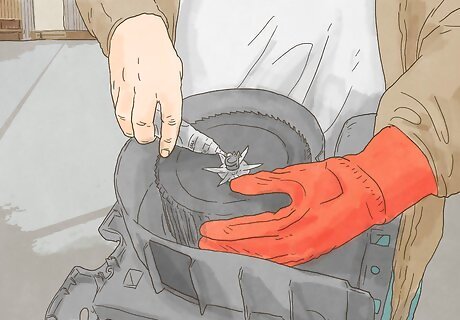
Possess an interest in machines. If you love to tinker with cars and machines, you’ll enjoy working as an auto body tech. The bulk of the job consists of adjusting and repairing things. You should have a mechanical aptitude if you wish to pursue this line of work.
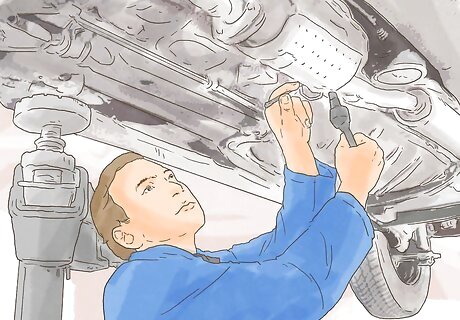
Try to repair or rebuild a junked car. Since fixing cars is what you’ll be spending most of your time doing as an auto body repair tech, you should get some hands-on practice before making a career of it. If you have dents or damage to your car, try to fix it using repair manuals and guides. You could also approach a family member or friend and explain that you’d like to get some experience in auto repair to help you prepare for your future career.
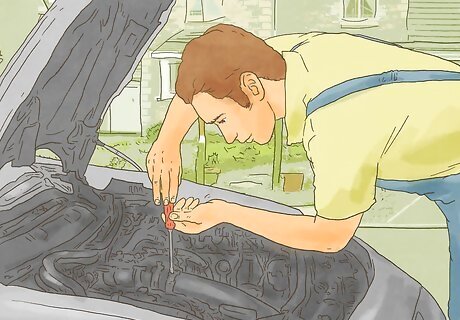
Be able to multitask. As an auto body repair technician, you’ll have a variety of duties that will change frequently. You should be able to work on a number of collision repair duties at the same time or on the same day. For instance, you might start by installing a new door on a damaged car, then replace a dented fender on another car, then sand and buff repaired surfaces.
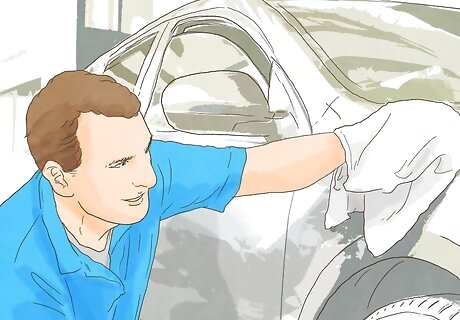
Enjoy working indoors. Auto repair technicians spend most of their time in a garage or another large indoor location. The location you work will be quite noisy due to the constant buzz of machinery. If you prefer working outdoors or in a more contemplative environment, you might want to look elsewhere for work. Besides the irritating noise, you should also be prepared to deal with dust and fumes caused by painting or sanding. Be sure to follow all relevant health and safety protocols when painting or sanding, since the debris can cause respiratory issues.

Have high physical stamina. Auto body repair techs often have to assume uncomfortable positions -- leaning over, sliding under, or kneeling beside cars. You will also have to manipulate heavy auto parts and equipment. If you do not wish to engage in strenuous activity, becoming an auto body repair tech might not be right for you.

Possess strong visualization skills. If you can read a two-dimensional diagram or repair manual and envision the part or section of the automobile in three dimensions, you’ll do well as an auto body repair tech. For instance, in order for a technician to restore a unibody vehicle to its original form, you must be able to follow instructions and diagrams, either in print form or digitally, and make precise measurements to ensure accurate placement of vehicle body sections relative to one another. Technicians must be detail oriented. Strong skills in geometry and art might help.

















Comments
0 comment